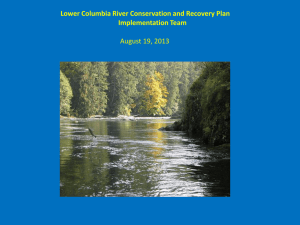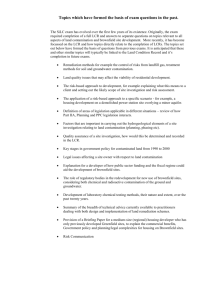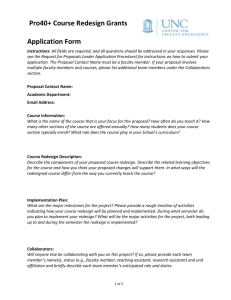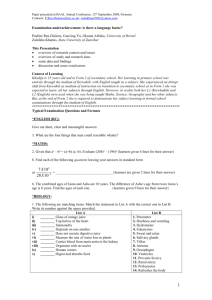Proposal File - Teaching Large Classes
advertisement
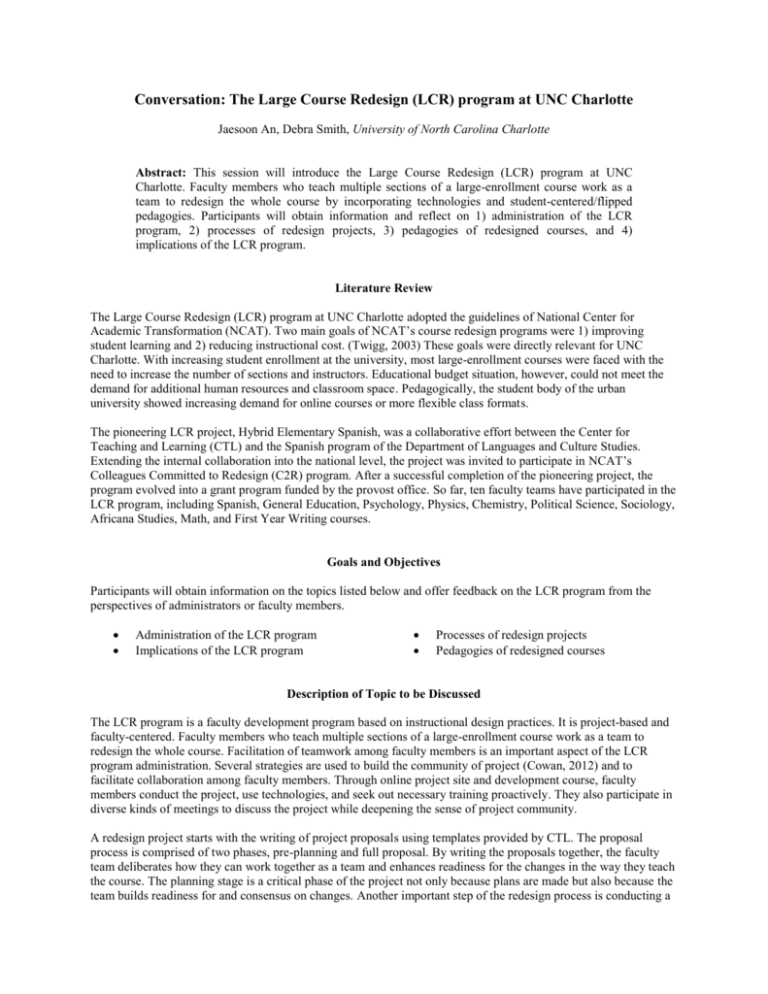
Conversation: The Large Course Redesign (LCR) program at UNC Charlotte Jaesoon An, Debra Smith, University of North Carolina Charlotte Abstract: This session will introduce the Large Course Redesign (LCR) program at UNC Charlotte. Faculty members who teach multiple sections of a large-enrollment course work as a team to redesign the whole course by incorporating technologies and student-centered/flipped pedagogies. Participants will obtain information and reflect on 1) administration of the LCR program, 2) processes of redesign projects, 3) pedagogies of redesigned courses, and 4) implications of the LCR program. Literature Review The Large Course Redesign (LCR) program at UNC Charlotte adopted the guidelines of National Center for Academic Transformation (NCAT). Two main goals of NCAT’s course redesign programs were 1) improving student learning and 2) reducing instructional cost. (Twigg, 2003) These goals were directly relevant for UNC Charlotte. With increasing student enrollment at the university, most large-enrollment courses were faced with the need to increase the number of sections and instructors. Educational budget situation, however, could not meet the demand for additional human resources and classroom space. Pedagogically, the student body of the urban university showed increasing demand for online courses or more flexible class formats. The pioneering LCR project, Hybrid Elementary Spanish, was a collaborative effort between the Center for Teaching and Learning (CTL) and the Spanish program of the Department of Languages and Culture Studies. Extending the internal collaboration into the national level, the project was invited to participate in NCAT’s Colleagues Committed to Redesign (C2R) program. After a successful completion of the pioneering project, the program evolved into a grant program funded by the provost office. So far, ten faculty teams have participated in the LCR program, including Spanish, General Education, Psychology, Physics, Chemistry, Political Science, Sociology, Africana Studies, Math, and First Year Writing courses. Goals and Objectives Participants will obtain information on the topics listed below and offer feedback on the LCR program from the perspectives of administrators or faculty members. Administration of the LCR program Implications of the LCR program Processes of redesign projects Pedagogies of redesigned courses Description of Topic to be Discussed The LCR program is a faculty development program based on instructional design practices. It is project-based and faculty-centered. Faculty members who teach multiple sections of a large-enrollment course work as a team to redesign the whole course. Facilitation of teamwork among faculty members is an important aspect of the LCR program administration. Several strategies are used to build the community of project (Cowan, 2012) and to facilitate collaboration among faculty members. Through online project site and development course, faculty members conduct the project, use technologies, and seek out necessary training proactively. They also participate in diverse kinds of meetings to discuss the project while deepening the sense of project community. A redesign project starts with the writing of project proposals using templates provided by CTL. The proposal process is comprised of two phases, pre-planning and full proposal. By writing the proposals together, the faculty team deliberates how they can work together as a team and enhances readiness for the changes in the way they teach the course. The planning stage is a critical phase of the project not only because plans are made but also because the team builds readiness for and consensus on changes. Another important step of the redesign process is conducting a pilot and collecting data for formative evaluation (Maslowski & Visscher, 1999). This process allows the team to reflect on the project to ensure that changes are made to produce better student learning experiences and outcomes. It also adds the dimension of Scholarship of Teaching and Learning (SOTL) to the redesign project, promoting continual innovation of the redesigned course or initiating new redesign projects in the department. In terms of the common pedagogies the redesigned courses, the faculty teams were more open to the idea of blending online activities with classroom-based activities than moving to 100% online instruction. This preference was supported by education studies showing better student learning outcomes in blended format than in 100% online format in general (Dziuban, Hartman & Moskal, 2004). Most teams reduced the lecture time or the class seat time (deNoyelles, Cobb, & Lowe, 2012) to allow for student-regulated learning activities in online systems or in face-toface small groups if teaching assistants and small classrooms were available. Pre-lecture online assignments were often given to introduce the content and to prepare students for the deeper learning to be facilitated in classroom sessions. More out-of-class resources such as resource centers and tutors were made available to help students to complete the increased amount of self-regulated activities. The general pedagogy of redesigned courses resembled that of the student-centered teaching (Eliason & Holmes, 2012) and the flipped classroom (Fulton, 2012). Multiple dimensions being involved in LCR projects, implications of the LCR program ranged over a variety of areas such as: Common learning across multiple sections Pedagogy training New course designators Classroom assignment Undergraduate teaching assistants Technology training and support Video production and editing eTextbook compatibility and purchasing Cost dimension of college classes Active classroom space Facilitation Techniques We will give a 10 min. talk presenting the topics described above and then open up for questions and discussion. To illuminate the critical planning stage of the LCR project, a pre-proposal template will be handed out. As a closing activity, participants will be asked to respond to a questionnaire intended to gather feedback on the LCR program. References Cowan, J. (2012). Strategies for developing a community of practice: Nine years of lessons learned in a hybrid technology education master’s program. TechTrends, 56(1), 12-18. deNoyelles, A., Cobb, C., & Lowe, D. (2012). Influence of reduced seat time on satisfaction and perception of course development goals: A case study in faculty development. Journal of Asynchronous Learning Networks, 16(2), 85-98. Dziuban, C., Hartman, J. & Moskal, P. (2004) Blended learning. ECAR Research Bulletin, 2004 (7), 1-12. Eliason, S. & Holmes, C. (2012). A course redesign project to change faculty orientation toward teaching. Journal of the Scholarship of Teaching and Learning, 12(1), 36-48. Fulton, K. (2012). Upside down and inside out: Flip your classroom to improve student learning. Learning & Leading with Technology, 39(8), 12-17. Maslowski, R. & Visscher, A. (1999). Formative evaluation in educational computing research and development. Journal of Research on Computing in Education, 32(2), 239-55. Twigg, C. (2003). Improving quality and reducing cost: Designs for effective learning. The Magazine of Higher Learning, 35(4), 22-29.




